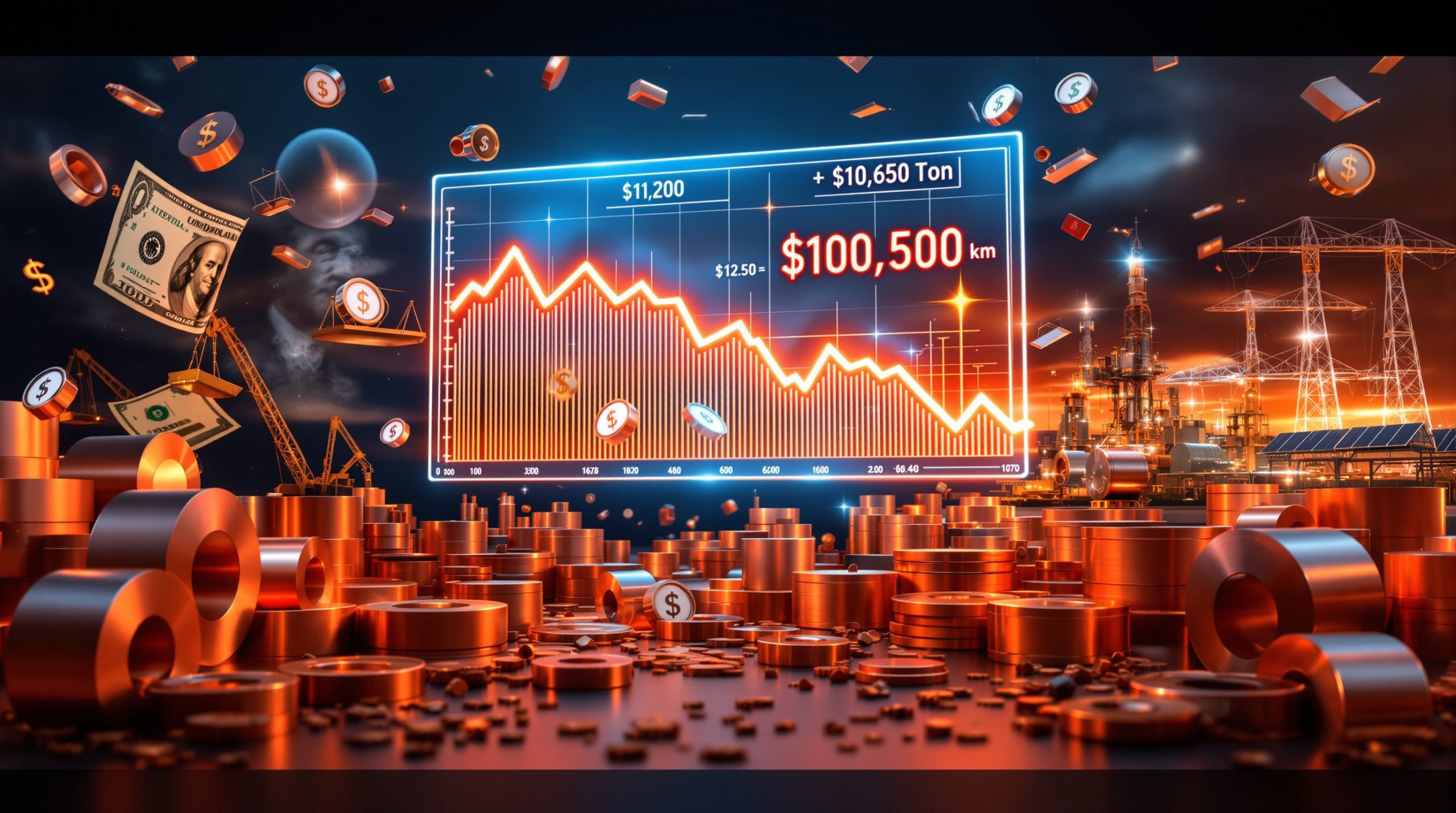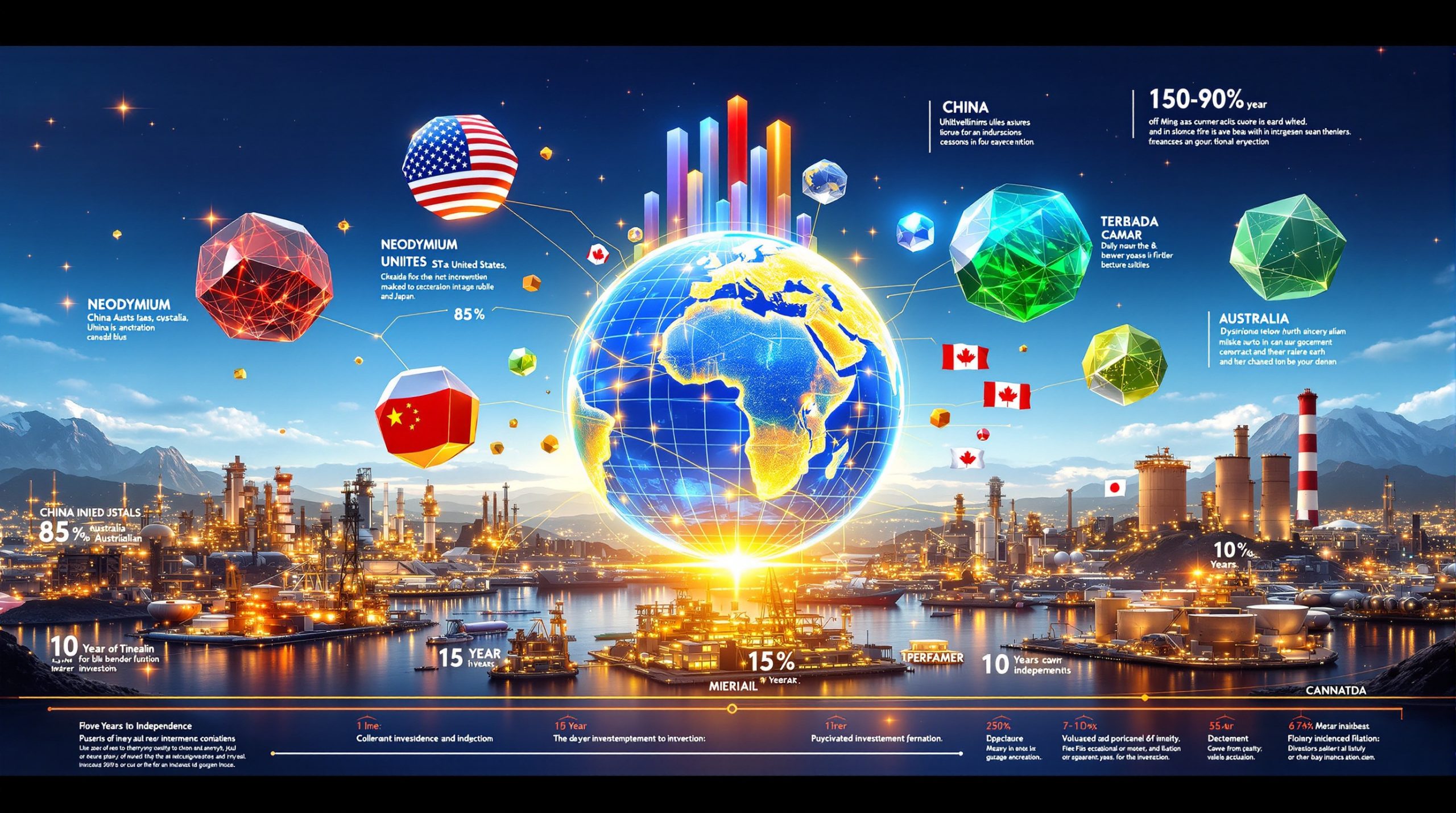Understanding Gadolinium Oxide Price Trends in Europe
European gadolinium oxide markets have experienced unprecedented volatility following China's export restrictions implemented on April 4, 2025. This strategic heavy rare earth element, crucial for technologies spanning healthcare to aerospace, has become a focal point in discussions around supply chain resilience and pricing transparency.
The launch of Fastmarkets' new European price benchmark—gadolinium oxide 99.99%-99.999%, ex-warehouse Rotterdam, $/kg—marks a significant development for market participants navigating these turbulent conditions. This dedicated European assessment complements the established Chinese export price assessment (gadolinium oxide 99.99%-99.999%, fob China, $/kg – MB-GD-0001).
"Price transparency has become absolutely critical for European manufacturers attempting to adapt their supply chains during these geopolitical shifts," notes Caroline Messecar, Fastmarkets analyst specializing in rare earth elements. "Without reliable benchmarks, companies simply cannot make informed procurement decisions."
According to industry data, price volatility increased approximately 30% in Q2 2025 compared to the previous quarter, driven largely by intensified buyer competition and dwindling Rotterdam port inventories, which plummeted to just 15 metric tons by May (down from 90 tons in March).
What Is Gadolinium Oxide and Why Is It Important?
Gadolinium oxide (Gd₂O₃) represents a critical heavy rare earth compound with unique properties that make it irreplaceable across numerous high-technology applications. Its exceptional neutron absorption capacity—measured at an impressive 49,000 barns—makes it particularly valuable in nuclear applications.
The Strategic Value of Gadolinium Oxide
The compound's strategic importance stems from its unique combination of electromagnetic, thermal, and nuclear properties. Unlike many other rare earth elements, gadolinium's 4f electron configuration enables exceptional versatility across vastly different industrial applications, from medical imaging to aerospace components.
European industries particularly depend on consistent, high-purity gadolinium oxide supplies for maintaining technological competitiveness. The material's scarcity and concentrated production (predominantly in China) creates inherent supply vulnerabilities for European manufacturers, contributing significantly to the ongoing critical minerals race.
Key Applications Driving Demand
- Healthcare: Gadolinium-based contrast agents enhance approximately 40 million MRI scans annually across Europe, providing the magnetic properties necessary for detailed soft tissue visualization
- Energy Sector: Thermal barrier coatings containing gadolinium oxide extend turbine blade lifespans threefold in high-pressure environments, with Siemens Energy's H-class turbines relying on these coatings to withstand operating temperatures up to 1,500°C
- Nuclear Industry: The International Atomic Energy Agency reports that "gadolinium-based control rods reduce reactor downtime by 12%" due to their exceptional neutron absorption capabilities, making them crucial safety and operational components
- Aerospace: High-performance alloys incorporating gadolinium achieve approximately 8% weight reduction in critical turbine components while maintaining structural integrity at extreme temperatures
How Have Recent Chinese Export Controls Affected European Markets?
The implementation of Chinese export controls on April 4, 2025, created immediate and profound disruptions throughout European supply chains dependent on gadolinium oxide and other heavy rare earth elements.
Market Disruption Timeline
The impact was both swift and severe: EU gadolinium imports from China dropped a staggering 62% month-over-month immediately following the export restrictions. This supply shock coincided with depleting inventories, creating a perfect storm for European consumers.
Key developments following the restrictions include:
- April 2025: Initial announcement triggered immediate price spikes of 25-30% in spot markets
- May 2025: Rotterdam port inventories fell to critical levels (15 metric tons)
- May 2025: French nuclear operator EDF halted two planned reactor upgrades due to gadolinium shortages
- June 2025: European Commission proposed 15% retaliatory duties on Chinese exports
Supply Chain Vulnerabilities Exposed
A confidential European Commission trade memo circulated in May acknowledged that the export controls "exposed a 78% dependency on Chinese HREEs" across critical European industries. This dependency reflects decades of market concentration and limited investment in alternative supply sources.
The restrictions specifically targeted seven heavy rare earth elements through export licensing and quota systems, creating significant administrative barriers even for quantities that technically remained available for export.
"What we're witnessing isn't simply a temporary market disruption," explains an EU Critical Raw Materials Alliance spokesperson. "It's a fundamental restructuring of global rare earth supply chains that will take years to fully resolve."
What Are the Current Price Trends for Gadolinium Oxide in Europe?
The European gadolinium oxide market now operates in uncharted territory, with prices reaching record levels and unprecedented spreads between European and Chinese assessments.
New Price Benchmark Introduction
Fastmarkets' Rotterdam benchmark has quickly established itself as the reference point for European transactions, reducing price discovery lag from approximately 14 days to just 3 days post-launch. This improved transparency has become crucial for contract negotiations and inventory management decisions.
The benchmark incorporates comprehensive inputs including:
- Verified transaction data from European consumers
- Supplier bids and offers in Rotterdam warehouses
- Validated buyer surveys across multiple industries
- Adjustments for logistics, tariffs, and EU compliance costs
Price Comparison Table: European vs. Chinese Markets
| Price Factor | European Market (Rotterdam) | Chinese Market (FOB) |
|---|---|---|
| May 2025 Price Point | $240/kg | $195/kg |
| Monthly Volatility | 18-22% | 8-12% |
| Premium Components | Includes 6% EU environmental compliance | Export license costs |
| Contract Duration | Typically 3-6 months | Typically 6-12 months |
| Warehousing Costs | €0.50/kg/month | Not applicable |
This price differential reflects not only logistics and compliance costs but also the significant risk premium European buyers now face. Dutch aerospace firm Fokker exemplifies the new purchasing strategies, having locked in 6-month contracts at $230/kg to mitigate ongoing volatility.
Why Is Market Transparency Critical for European Consumers?
The introduction of dedicated European price assessments provides crucial market intelligence during a period of exceptional supply chain disruption. This transparency delivers multiple tangible benefits to market participants.
Decision-Making Under Uncertainty
Research indicates that 89% of European manufacturers reduced R&D budgets specifically due to input cost uncertainty in Q2 2025. Transparent, reliable pricing alleviates this uncertainty, enabling companies to:
- Calculate accurate production costs and maintain profit margins
- Develop strategic hedging positions to mitigate future volatility
- Negotiate contracts with suppliers and customers from an informed position
- Justify price adjustments to downstream customers with credible third-party data
Philips Healthcare provides a compelling case study, having revised its MRI production forecasts using Fastmarkets data immediately following the April 2025 export controls. This data-driven approach allowed them to maintain production schedules while competitors faced disruptions.
Cross-Sector Impact Assessment
The EU Critical Raw Materials Alliance reports that "transparent pricing reduces hedging costs by 22%" across member companies. This efficiency becomes particularly crucial during supply disruptions, when price volatility can otherwise lead to:
- Procurement teams paying significant premiums due to information asymmetry
- Finance departments struggling to forecast materials costs accurately
- Strategic planners delaying capacity expansions due to input price uncertainty
- R&D teams facing budget constraints for next-generation technologies
"Without reliable price benchmarks, European industry would essentially be operating blindfolded during this critical transition period," notes Caroline Messecar of Fastmarkets.
How Are European Supply Chains Adapting?
European consumers are actively pursuing diversification strategies to reduce dependency on Chinese gadolinium supplies, with both public and private initiatives gaining momentum.
Diversification Initiatives
The most significant developments include:
- Recycling Investment: Caremag's €216 million French recycling plant aims to recover 500 tons of rare earth elements annually by 2026, including substantial gadolinium volumes from medical devices and industrial components
- Mining Development: The EU has allocated €1.2 billion for rare earth mining permits in Sweden and Greenland, though full production remains 8-10 years away given extensive permitting requirements
- Efficiency Improvements: Solvent extraction efficiency in gadolinium recycling has improved from 65% to 82% through innovative ion-exchange technologies developed at the Fraunhofer Institute
- Urban Mining: BMW's pioneering urban mining pilot successfully recovered 80kg of gadolinium from 10,000 electric vehicle motors in Q1 2025, demonstrating commercial viability
Industry Expert Perspective
Ramon Barua, CEO of Aclara Resources, offers an optimistic assessment: "Recycling initiatives could realistically meet 20% of European gadolinium demand by 2030 if proper incentives remain in place. Alternative rare earth prices are key to ensuring that a more robust and reliable supply chain for these elements becomes a reality."
Nevertheless, industry analysts caution that diversification efforts face significant hurdles, including technical challenges, regulatory complexity, and economic viability concerns compared to traditional mining.
What Is the Outlook for European Gadolinium Oxide Markets?
The European gadolinium market faces both short-term challenges and long-term structural changes as it adapts to the new supply reality.
Short-Term Market Dynamics
European consumers will likely continue experiencing elevated prices and potential supply constraints throughout 2025-2026. Key factors shaping the immediate outlook include:
- Sustained price premiums of 20-25% above Chinese domestic prices
- Lengthening procurement lead times (currently averaging 45 days, up from 14 days in early 2025)
- Strategic stockpiling by major consumers creating additional demand pressure
- Emerging grey market activity with Malaysian intermediaries charging approximately 25% premiums
According to Messecar of Fastmarkets, "Price convergence with China appears unlikely before 2027, as new supply sources require significant time to develop capacity and establish reliability."
Long-Term Market Evolution
The European market is undergoing fundamental restructuring, driven by both necessity and strategic policy. The EU's Critical Raw Materials Act targets 35% domestic rare earth processing capability by 2030, supporting initiatives including:
- Development of high-efficiency extraction technologies for European deposits
- Creation of specialized processing facilities for recovered gadolinium
- Research into synthetic alternatives, projected to capture 15% market share by 2030
- Approximately €300 million in EU grants allocated for alternative materials research in 2025
A notable technical challenge involves the complex processing requirements for high-purity gadolinium, with 99.999% purity grades requiring an 18-step refining process compared to just 9 steps for 99.99% material. This processing complexity contributes to the 35% price premium commanded by the highest purity grades.
What Alternatives Exist for European Consumers?
European manufacturers are exploring multiple pathways to reduce gadolinium dependency, including material substitution, efficiency improvements, and supply diversification.
Emerging Supply Sources
The most promising alternative supply initiatives include:
- Domestic Recycling: Besides Caremag's flagship project, smaller specialized recycling operations are emerging across Europe, focusing on gadolinium recovery from specific waste streams
- Mineral Exploration: Geological surveys in Finland and Sweden have identified promising HREE deposits containing gadolinium, though development timelines extend to 2028-2030
- Efficiency Technologies: Plasma spray deposition techniques have reduced gadolinium coating requirements by 40% in certain turbine applications, demonstrating how efficiency can partially offset supply constraints
- International Partnerships: European manufacturers are establishing joint ventures with Australian and Canadian rare earth developers, securing offtake agreements for future production
Recycling and Urban Mining Potential
Recycling represents perhaps the most immediate opportunity to supplement European gadolinium supplies. Current recovery rates remain low (under 5% for medical gadolinium), primarily due to:
- Complex separation requirements when gadolinium is incorporated into alloys
- Dispersion of end-of-life products across numerous waste streams
- Economic challenges in collection and processing at commercial scale
However, BMW's successful urban mining pilot recovered 80kg of gadolinium from 10,000 EV motors in Q1 2025, demonstrating significant untapped potential. Life cycle assessment (LCA) studies indicate that recycled gadolinium produces approximately 65% less CO₂ equivalent per kilogram compared to newly mined material, providing both environmental and supply chain benefits.
How Does Gadolinium Fit Into the Broader Rare Earths Market?
Gadolinium's market dynamics must be understood within the context of the broader rare earths landscape, particularly among heavy rare earth elements.
Heavy Rare Earths Context
Gadolinium constitutes approximately 8% of global HREE production compared to 42% for dysprosium, placing it in the mid-tier of heavy rare earth elements by volume. This positioning creates unique market dynamics:
- Less overall volume than dysprosium, creating potential for greater price volatility
- Wider range of applications than some other HREEs, providing some demand flexibility
- Processing typically occurs alongside other HREEs, linking its production to broader rare earth market conditions
The U.S. Geological Survey's 2025 report warns that "HREE supply deficits will reach 25,000 tons annually by 2030" without significant new production capacity, positioning gadolinium within a broader structural shortage. For a comprehensive overview of reserves and production, refer to the global rare earth insights report.
Geopolitical Considerations
Rare earth elements, including gadolinium, have become geopolitical pawns in broader trade tensions. Key developments include:
- EU's 90-day strategic reserve mandate for critical rare earths by 2026
- Proposed international rare earth cooperation framework among G7 nations
- Australian-EU critical minerals partnership focusing on rare earth development
- Japanese investments in recycling technologies to reduce import dependency
"The politicization of rare earth supply chains represents perhaps the most significant challenge for European manufacturers," notes an EU Critical Raw Materials Alliance representative. "Technical solutions exist for many supply challenges, but geopolitical tensions can override market solutions."
The situation with gadolinium oxide demonstrates the broader issues of critical mineral shortages affecting multiple industries worldwide. Understanding these dynamics requires awareness of historical commodity cycles insights to navigate market fluctuations effectively.
FAQ: European Gadolinium Oxide Market
What purity grades of gadolinium oxide are most in demand in Europe?
High-purity grades (99.99%-99.999%) dominate European demand, with the 99.999% grade commanding a 35% price premium over 99.99% material due to its applications in advanced medical imaging and specialized electronics. The 18-step refining process required for ultra-high purity contributes significantly to this premium. According to current gadolinium oxide price forecasts, this premium is expected to persist.
How do European prices compare to global benchmarks?
European prices (Rotterdam) consistently exceed Chinese FOB prices by 20-25%, reflecting several factors:
- Logistics costs (approximately 5-8%)
- EU environmental compliance surcharges (6%)
- Supply risk premiums (7-12%)
- Warehousing costs (€0.50/kg/month in Rotterdam)
This differential has widened since April 2025 as European buyers compete for limited available material.
What industries are most affected by gadolinium price fluctuations?
The impact varies significantly across sectors:
- Healthcare: Medical device manufacturers reported 15-20% cost increases for MRI contrast agents post-April 2025, with potential implications for scanning costs
- Nuclear: Component costs for gadolinium-based control rods have risen approximately 25%, affecting maintenance schedules at several European plants
- Aerospace: Specialized alloy producers face 30-35% input cost increases, particularly challenging for fixed-price contract holders
- Electronics: Sensor manufacturers using gadolinium report 15-18% margin compression due to limited ability to pass costs downstream
How are European policies addressing rare earth supply challenges?
European policymakers have implemented a multi-faceted approach:
- Critical Raw Materials Act: Targets 35% domestic rare earth processing by 2030
- Research Funding: €300 million in 2025 grants for alternative materials
- Recycling Incentives: Tax benefits for companies investing in rare earth recovery
- Strategic Reserves: Mandated 90-day inventory requirements by 2026
- International Partnerships: Bilateral agreements with Australia, Canada, and Vietnam focused on rare earth development
These policy initiatives aim to create a more resilient European rare earth ecosystem while acknowledging the significant timeline required for full implementation. Unlocking critical minerals remains a top priority for ensuring future technological advancements.
*Disclaimer: This article contains forward-looking statements regarding market developments, pricing trends, and supply chain adaptations. Actual outcomes may differ from projections due to numerous factors including geopolitical developments, technological breakthroughs, and regulatory changes.
Want to Stay Ahead of the Next Major Mineral Discovery?
Discovery Alert's proprietary Discovery IQ model instantly notifies investors about significant ASX mineral discoveries, helping you identify actionable opportunities before the broader market. Explore why major discoveries can lead to exceptional returns by visiting the Discovery Alert discoveries page and position yourself for your next potential investment success.




